
Project Milestones Explained: Your Roadmap to Successful Project Completion
Working on a project without clear milestones is like running a marathon with no mile markers, where you lose track of how far you’ve come and how much is left.
Here’s what happens when they’re missing:
- Teams pour effort into work, but can’t feel the momentum building
- Progress becomes invisible, even when you’re actually moving forward
- What started as an exciting goal turns into an endless grind
The breakthrough isn’t working harder, but creating visible wins along the way that prove you’re making real progress.
In this blog, we’ll break down project milestones, why they matter, and how to set and manage them so your team stays focused and crosses the finish line strong.
Let’s dive in!
What are Project Milestones?
Project milestones are practical checkpoints or events in a project’s lifecycle that mark progress and signify the completion of major deliverables or phases.
In project management, project managers use milestones as a planning tool to track progress toward an ultimate goal.
They function as fundamental markers that show:
- Phase endings
- Key deliverables
- Important decisions
- Significant events or dates
Simply put, milestones are reference points that mark significant accomplishments and indicate when the project is ready to advance to the next stage. They are zero-duration markers representing task completion rather than tasks themselves.
How Project Milestones Differ from Project Goals, Deliverables, and Tasks
To track project milestones, it’s important to understand how they differ from project goals, deliverables, and tasks.
Let’s break down these distinctions clearly-
| Project terms | Key difference | Example |
| Project Milestones vs. Project Goals | Project goals are broad outcomes you want to achieve, whereas milestones are specific moments that mark progress toward those goals | Goal: “Increase blog traffic by 50% in 6 months” Milestone: “Content calendar for Q1 approved” – a specific progress marker toward that traffic goal |
| Project Milestones vs. Project Deliverables | Project deliverables are the tangible outputs you create, and milestones mark the celebration moments when those outputs successfully reach completion | Deliverable: “20 SEO-optimized blog posts with graphics” Milestone: “Content creation phase completed” – when those deliverables are finished and ready for publishing |
| Project Milestones vs. Tasks | Tasks are individual work activities that require time and effort to complete, while milestones are zero-duration markers that acknowledge when the work reaches completion | Task: “Write a blog post about project management.” Milestone: “Week 1 publishing schedule completed” – the instant moment when all weekly tasks are finished |

Level up your WordPress project management game with this Trello equivalent solution – where limitless possibilities come at an unbeatable price!
The Importance of Milestones in Project Management
The value of milestones becomes undeniable when you look at how often their absence leads to major failure.
According to the Project Management Institute, 37% of project failures result from unclear objectives and milestones
The points below show the benefits of milestones for successful projects:
Stay focused on goals
Projects without milestones become chaotic and risk never reaching their project goals. Milestones break down complex initiatives into a manageable project to-do list, providing a clear roadmap that keeps teams focused on the ultimate objective.
Track progress with real clarity
Milestones create meaningful checkpoints that show whether you’re truly moving forward or just staying busy. They serve as reference points to spot delays early and take corrective action before problems escalate.
Align teams with purpose
When project teams know the next milestone, prioritizing becomes easier and guesswork disappears. Milestones create shared visibility that keeps everyone aiming in the same direction with a clear purpose.
Improved planning and scheduling
Milestones break large projects into structured phases, whether you’re using Gantt charts, Kanban boards, calendar views, or the critical path method. This structure enables more accurate planning and realistic timelines that teams can achieve.

Step into the Future of Project Management!
Simplify stakeholder communication
Stakeholders need clarity, not overwhelming details. Milestones provide simple, meaningful progress points for sharing updates, reviewing deliverables, and gaining approvals without task-level complexity.
Allocate resources strategically
Milestones identify when deliverables and phases are due, helping allocate time, people, and tools more effectively. This foresight prevents bottlenecks and ensures resources are available when needed.
Maintain morale and momentum
Long projects create fatigue, but milestones offer achievement moments worth celebrating. They provide tangible progress markers that reinforce motivation even when final goals seem distant.
Create risk management checkpoints
Every milestone offers an opportunity to assess and adjust the course. Early detection of issues reduces late-stage surprises and enables informed decision-making throughout the project lifecycle.
Also read: Why Project Management is Important?
How to Set and Manage Project Milestones Effectively
Here’s how to set and manage project milestones effectively, step by step, for a structured and successful project journey-
Understand project goals, objectives, and scope
Before setting project milestones, it’s important to first understand what the project needs to accomplish. This means collecting requirements and aligning with stakeholders to clarify the following:
- Project Goals: The broad outcomes the project is meant to deliver
- Project Objectives: Specific actions or measurable results that support those goals
- Project Scope: The boundaries of the work: what’s included and what isn’t
- Project Constraints: Any limits related to time, budget, or available resources
With SMART goals, you can organize the project around clear priorities, link each part of the work to a defined outcome, and identify where milestones should be placed to measure progress.
For a better understanding, also read: How project goals differ from project objectives
Break the project into phases
Now, organize the work into distinct phases that create a logical progression from start to finish, including:
- Initiation
- Planning
- Execution
- Monitoring and Control
- Closure
By breaking projects into phases, the overall project workload becomes more manageable through smaller, monitorable components with clear boundaries.
Also, this structure allows you to set specific objectives for each stage and easily identify where milestones should be placed to track progress effectively.
Identify key deliverables for each phase
After breaking the project into phases, focus on identifying the key project deliverables that reflect real progress within each stage. These are the specific outputs or decisions that move the project forward and signal completion of significant work.
So, when you define clear deliverables, you establish what success looks like and create the foundation for milestones that track actual progress, not just dates.
Create a work breakdown structure (WBS)
With your deliverables identified in each phase, create a Work Breakdown Structure (WBS) to break them into manageable parts. Start by outlining the main tasks needed for each deliverable.
Track these tasks using a Kanban board as they move through To Do, In Progress, and Completed, making milestone progress visible throughout.
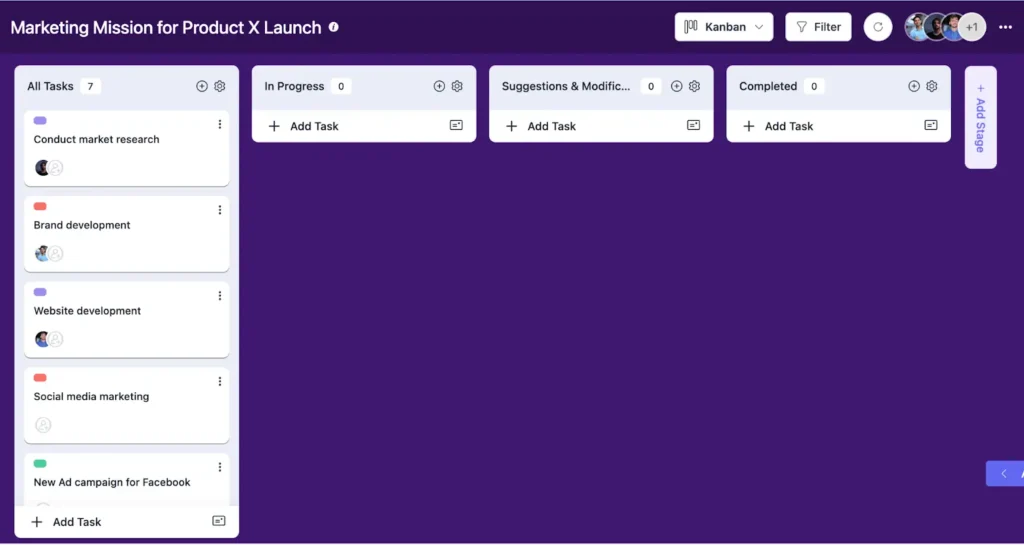
Each task should be divided into clear, actionable subtasks to make the work more achievable and easier to track.
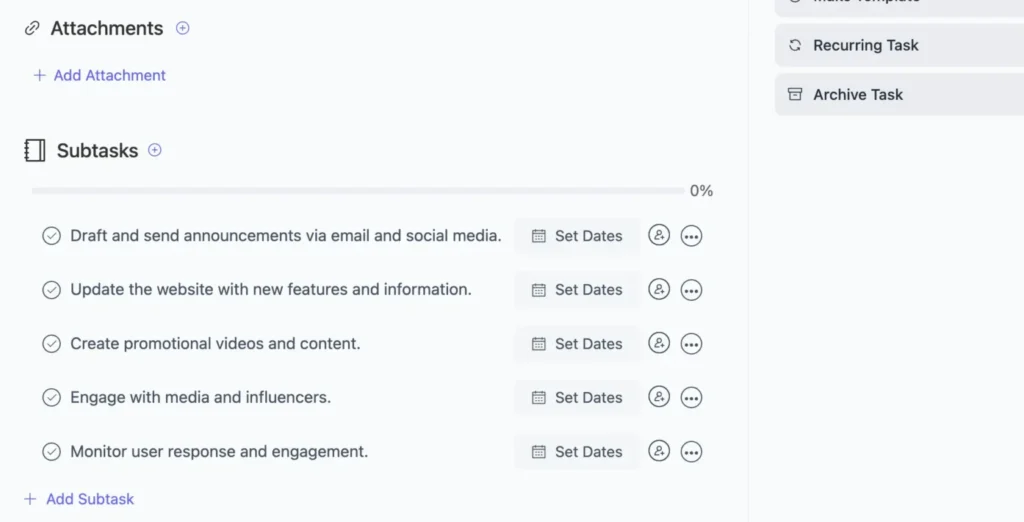
This way, you can manage complexity more effectively, highlight real progress by placing milestones at key points, such as when a group of subtasks is completed.
Set realistic deadlines
Estimate the time required for each task and subtask based on complexity, resources, and team availability.

Then map those estimates to your project phases, using milestones as checkpoints to guide the overall schedule.
This ensures every deadline supports progress toward key outcomes without overloading the team.
Assign responsibilities
To keep milestones on track, clearly define who is accountable for each milestone to ensure nothing falls through the cracks.
This involves assigning and clarifying responsibilities so each team member understands their role, tasks, and expected outcomes.
Which typically include producing deliverables, meeting project milestones, and reporting to the project manager.
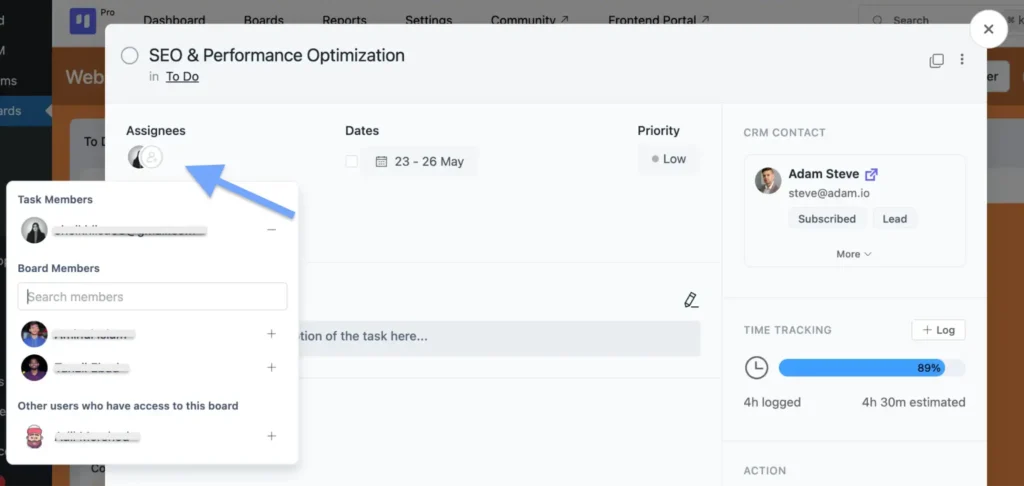
Also, consider task dependencies when assigning roles and responsibilities to maintain a smooth workflow and avoid risking bottlenecks.
Track milestone progress
As the team starts working toward their assigned outcomes, you need to know if things are actually moving forward along the way.
This means tracking milestones effectively by monitoring what’s completed, what’s delayed, and which tasks contribute most, while ensuring milestone progress stays aligned with Key Project Performance Indicators.
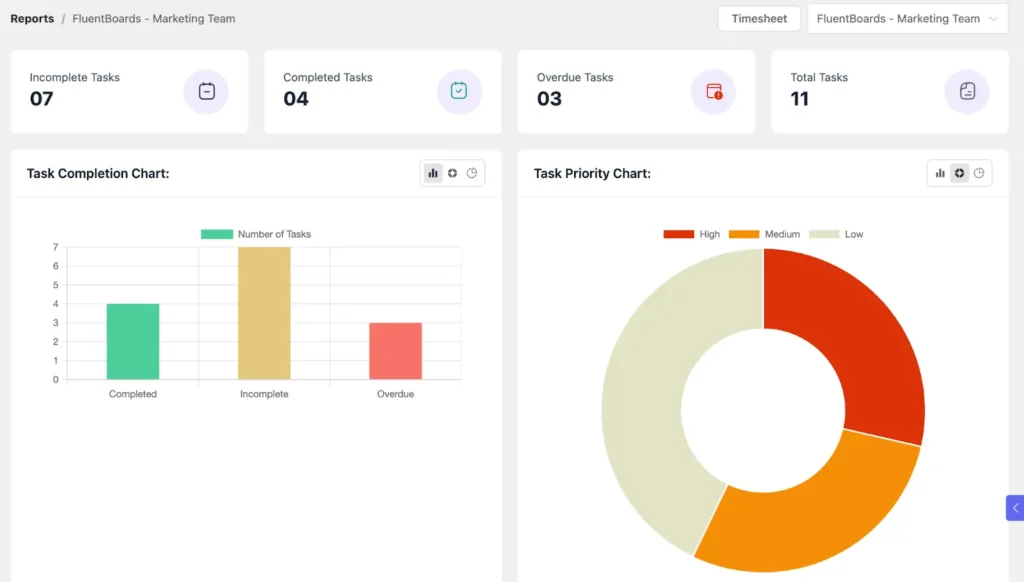
Additionally, subtask completion adds another layer, as these smaller checkpoints act as early signals of progress.
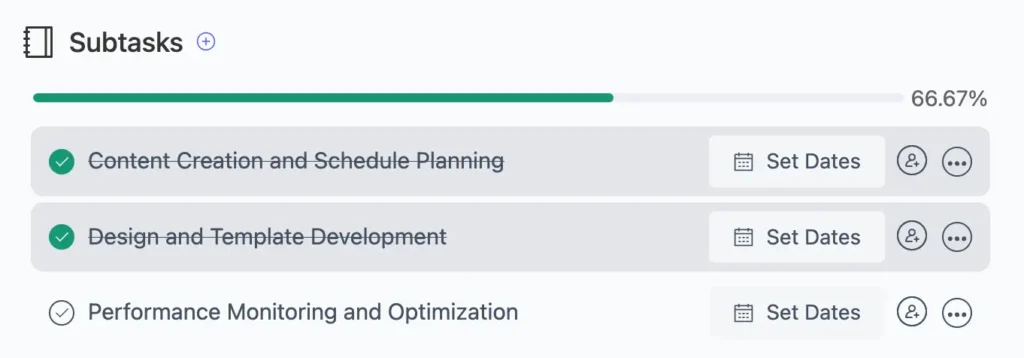
When you track progress this way, milestones become more than markers; they become a reliable measure of project health and momentum.
Communicate, adjust, and move forward
In the process of tracking progress, maintain regular communication with your team and stakeholders to stay aligned on progress, expectations, and any changes along the way.
Throughout the project lifecycle, revisit your milestones, timelines, and responsibilities to make necessary adjustments based on real-time feedback or roadblocks.
Celebrate milestone completions to acknowledge team effort and keep morale high. A quick win, even a small one, can re-energize the team and reinforce a sense of progress.
Examples of Project Milestones in Real-World Projects
Let’s walk through how they function in real-world project management workflows across each phase:
Project initiation milestones
Before a project gains traction, it needs direction. Milestones at this stage confirm whether the project is worth pursuing, who will be involved, and what it’s trying to achieve. These early decisions create the foundation for everything ahead.
Milestone checkpoints:
- Project proposal reviewed and approved
- Key stakeholders identified and confirmed
- Product direction clarified (e.g., core feature or enhancement defined)
- The core team (development, marketing, support, motion design) assembled
- Kickoff meeting conducted with aligned goals and responsibilities
Example:
To develop a new analytics dashboard, leadership approves the proposal, assigns a cross-functional team, defines the dashboard’s purpose, and holds a kickoff session to set expectations across all departments.
Project planning milestones
Once the project is greenlit, planning milestones signal whether you’re truly ready to execute. From defining the scope to assigning timelines and identifying risks, each milestone confirms that your project has structure—not just enthusiasm.
Milestone checkpoints:
- Project scope finalized and signed off
- Project charter developed
- Work Breakdown Structure (WBS) created and approved
- Timeline, resource plans, and tools selected
- Risk management and communication strategies agreed
Example:
For the analytics dashboard, the team builds out the WBS covering backend, UI, and marketing assets; creates an 8-week release timeline; assigns developers and designers; and identifies risks like integration delays.
Project execution milestones
This is where planning turns into output. Milestones here aren’t just “task complete” checkboxes; they represent visible progress, internal approvals, and production moments that bring the project to life.
Milestone checkpoints:
- First version of the feature completed
- 50% development review with all departments
- QA passed for internal build
- Promotional content (video, blog drafts) approved
- Go/no-go meeting for public launch readiness
Example:
The development team finalizes the first dashboard build, QA confirms performance benchmarks, the motion graphics team wraps up the launch video, and the marketing team gets campaign assets reviewed, followed by a leadership check-in to decide if it’s ready to go live.

FluentRoadmap Comes Free with FluentBoards Pro!
Project monitoring milestones
During execution, this phase keeps your project from quietly drifting off course. Milestones here give visibility into whether deadlines, budgets, and expectations are being met—and highlight issues early enough to solve them.
Milestone checkpoints:
- Mid-project performance review completed
- Budget usage reviewed with finance
- Timeline adjustments approved
- Change requests are documented and communicated
Example:
At the halfway mark, the team realizes API integration is running behind. A change request is raised, a revised timeline is approved, and the backlog is reprioritized to keep other work on schedule. Performance metrics are shared across teams for full transparency.
Project closure milestones
Final milestones are about wrapping things up, not just delivering, but ensuring everything is complete, documented, and ready for what’s next. These markers bring formal closure and team-wide clarity.
Milestone checkpoints:
- Final product or feature deployed and accepted
- Support team briefed and ready for client handover
- Post-launch performance reviewed
- Final review meeting conducted
- Documentation completed and archived
Example:
The dashboard goes live. Support receives training materials and troubleshooting guides. A review meeting captures feedback across teams, the marketing team shares performance data from the launch campaign, and the project lead archives all assets for future reference.
Common Project Milestone Mistakes to Avoid
Here are eight common pitfalls that can quietly derail your milestone progress:
- Setting too many milestones clutters the roadmap, making it harder to prioritize and confusing the team about what truly matters
- Using milestones as tasks blurs the line between progress indicators and to-dos, often misleading stakeholders
- Celebrating milestones without checking quality leads to false progress and risks delivering subpar outcomes
- Being overly optimistic with deadlines creates pressure and often results in missed milestones or burnout
- Changing requirements mid-phase disrupts flow and forces unnecessary pivots, finish one milestone before shifting scope
- Keeping milestones separate from tasks and timelines disconnects context and reduces project visibility
- Updating stakeholders irregularly causes misalignment, delayed feedback, and potential derailments
- Skipping risk planning around milestones leaves no buffer for recovery when issues arise, threatening overall delivery
Learn more: 20+ Proven Project Management Tips
Your Project Milestone Roadmap to Success
Every successful project follows a clear roadmap, and milestones are the critical checkpoints that guide the way.
As Vincent Van Gogh once said, “Great things are not done by impulse but by a series of small things brought together.”
Your project milestones are exactly those small things that, when connected, create something remarkable.
So plan your milestones early, use them to keep your team focused, and let them steer your project toward successful completion.
Thanks for reading! Hope your next project flows milestone by milestone.
Let’s redefine project management with FluentBoards!
Get Tips, Tricks, & Updates
We won’t send you spam.









![how to create a project management workflow [x steps] (2)](https://fluentboards.com/wp-content/uploads/2025/11/How-to-create-a-project-management-workflow-x-steps-2-768x402.webp)




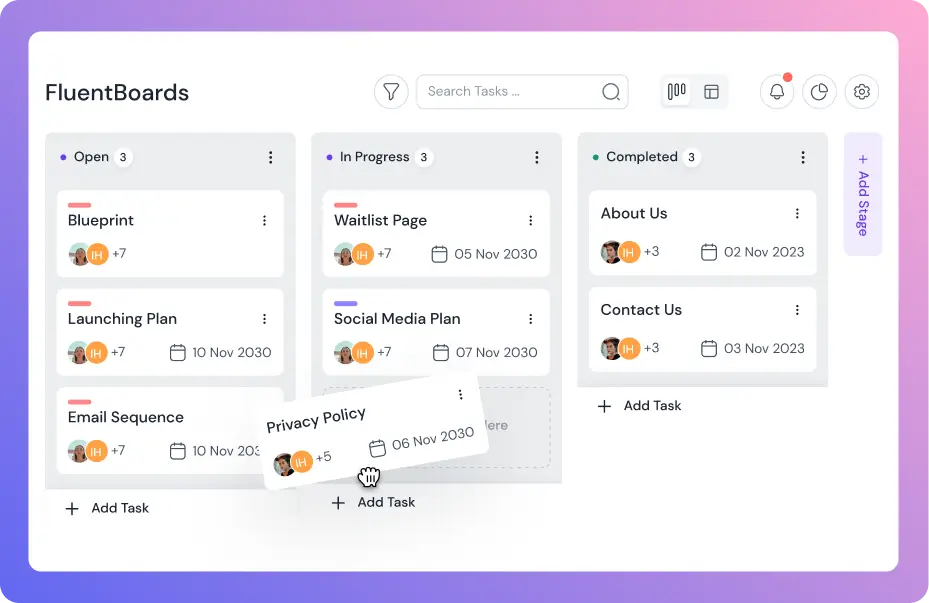
Leave a Reply